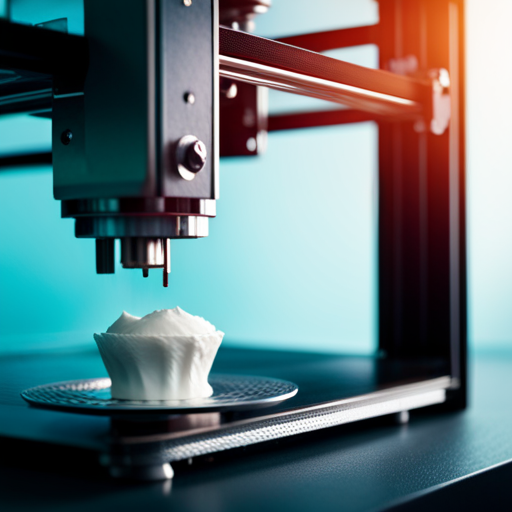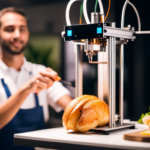In an era of unprecedented technological advancements, the emergence of 3D printed edibles is reshaping the food industry.
However, as this innovative technology gains traction, concerns about food safety have been raised.
This article delves into the critical aspects of material safety, hygiene standards, contamination risks, regulatory measures, and consumer education in the context of 3D printed edibles.
Through analytical and evidence-based insights, it aims to provide a comprehensive understanding of the challenges and opportunities in ensuring food safety within this burgeoning field.
Material Safety and Quality Control
How can 3D printed edibles ensure material safety and quality control to meet food safety standards?
Material testing and certification play a pivotal role in ensuring the safety and quality of 3D printed edibles. As this innovative technology gains traction in the food industry, rigorous testing and certification processes must be in place to guarantee the materials used are food-grade and safe for consumption.
Quality control and monitoring throughout the 3D printing process are essential to identify and rectify any potential contamination or defects in the printed edibles. Material testing involves analyzing the chemical composition and physical properties of the printing materials to ensure they comply with food safety regulations. Certification from regulatory bodies further validates the safety and quality of the materials used in 3D printed edibles.
Quality control measures, such as real-time monitoring of printing parameters and post-printing inspections, help mitigate any risks associated with contamination or substandard production. Implementing robust material testing, certification, and quality control protocols is imperative to instill consumer confidence and meet the stringent food safety standards governing the production of 3D printed edibles.
Hygiene Standards in Production
In the production of 3D printed edibles, adherence to stringent hygiene standards is essential for ensuring the safety and quality of the final food products. To maintain high hygiene standards in the production of 3D printed edibles, the following practices should be rigorously implemented:
-
Sanitization Protocols: Establish and enforce strict sanitization protocols for all equipment, surfaces, and tools used in the production environment. Regular cleaning and disinfection are crucial to prevent cross-contamination and microbial growth.
-
Personal Hygiene Measures: Implement comprehensive personal hygiene practices for all personnel involved in the production process. This includes the use of protective clothing, handwashing procedures, and the prohibition of food or drink consumption in designated production areas.
-
Air Quality Control: Ensure proper ventilation and air filtration systems are in place to maintain a clean and contaminant-free production environment. This is essential for minimizing the risk of airborne contaminants compromising food safety.
-
Training Programs: Provide thorough training programs for all staff members regarding hygiene practices and the importance of maintaining a hygienic production environment. Regular training and reinforcement of hygiene protocols are crucial for upholding consistent standards.
Potential Contamination Risks
Addressing potential contamination risks in the production of 3D printed edibles requires a thorough understanding of the sources and pathways through which contamination may occur. Preventing contamination and ensuring safety are paramount in 3D printed food production. Contamination can arise from various sources such as raw materials, equipment, and the production environment. Pathways for contamination may include cross-contact, biological, chemical, or physical hazards.
| Potential Contamination Sources | Pathways for Contamination | Preventive Measures |
|---|---|---|
| Raw materials | Cross-contact | Strict supplier screening and quality control procedures |
| Equipment | Biological hazards | Regular cleaning, sanitation, and maintenance protocols |
| Production environment | Chemical hazards | Monitoring and controlling storage of chemicals and ingredients |
| Physical hazards | Implementation of safety measures and employee training |
The implementation of Hazard Analysis and Critical Control Points (HACCP) and Good Manufacturing Practices (GMP) is crucial for preventing contamination. Additionally, regular testing for contaminants and strict adherence to food safety regulations are essential for ensuring the safety of 3D printed edibles. By addressing potential contamination risks through rigorous preventive measures, the production of 3D printed edibles can maintain the highest standards of safety and quality.
Regulatory Measures and Compliance
To ensure the safety and quality of 3D printed edibles, adherence to regulatory measures and compliance with food safety standards is imperative, extending the focus from preventive measures to formalized oversight and control. The following are critical aspects of regulatory oversight and industry compliance in the context of 3D printed edibles:
-
Regulatory Framework:
Establishing a comprehensive regulatory framework specific to 3D printed edibles is essential to address the unique production and safety considerations associated with this emerging technology. -
Quality Control Standards:
Implementing stringent quality control standards that encompass the entire 3D printing process, from raw material selection to the final product, is crucial to ensure the safety and integrity of 3D printed edibles. -
Certification and Auditing:
Mandating certification of 3D printing facilities and conducting regular audits to verify compliance with food safety regulations are fundamental steps in maintaining industry standards. -
Collaboration with Regulatory Agencies:
Collaboration between industry stakeholders and regulatory agencies is paramount for the development of guidelines and standards that align with evolving technological advancements and consumer safety requirements.
As the regulatory landscape continues to evolve, it is essential to educate consumers about the measures in place to ensure the safety of 3D printed edibles.
Consumer Education and Awareness
Consumer education and awareness play a crucial role in ensuring the safe adoption of 3D printed edibles. Educating consumers on safe printing practices, material selection, and potential risks associated with 3D printed food items is imperative.
Educating on Safe Printing
Promoting awareness of safe 3D printing practices is essential for ensuring the consumer’s understanding and confidence in the production of 3D printed edibles. To achieve this, the following measures should be considered:
-
Clear Guidelines: Providing clear and concise guidelines on safe handling and storage of 3D printed edibles.
-
Educational Resources: Developing educational resources such as pamphlets, online modules, and videos to inform consumers about safe printing practices.
-
Regulatory Standards: Ensuring that 3D printed edibles adhere to regulatory standards for food safety and quality.
-
Consumer Engagement: Encouraging consumer engagement through workshops, demonstrations, and interactive platforms to address any concerns and queries regarding safe 3D printing.
Raising Awareness About Risks
Raising awareness about the potential risks associated with consuming 3D printed edibles is crucial in ensuring consumer safety and confidence in the emerging technology. Risk assessment plays a pivotal role in identifying and mitigating potential hazards linked to 3D printed food.
Consumer perceptions of this technology are shaped by their understanding of the associated risks. Educating consumers about the importance of stringent quality control measures, material safety, and adherence to food regulations can help in fostering trust and acceptance.
Furthermore, highlighting the need for standardized testing and certification processes can aid in assuring consumers of the safety of 3D printed edibles. By addressing these concerns through targeted consumer education and awareness campaigns, the industry can build a foundation of trust and alleviate apprehensions surrounding the consumption of 3D printed foods.
Future Innovations and Research Initiatives
The future of 3D printed edibles lies in the development of novel food-safe materials that meet regulatory considerations and standards.
Researchers and industry professionals are actively exploring materials that are not only safe for consumption but also suitable for 3D printing processes.
Moreover, understanding consumer acceptance trends will be crucial in guiding future innovations and research initiatives in this emerging field.
Novel Food-Safe Materials
One key determinant for the future of 3D printed edibles lies in the development of novel food-safe materials. The following are crucial considerations for material innovation and printing safety in the context of edible compatibility and manufacturing processes:
-
Biodegradable Polymers: Research into biodegradable polymers can lead to the development of sustainable and food-safe materials for 3D printing edibles.
-
Food-Grade Certification: Collaboration between material scientists and regulatory bodies is essential to establish clear guidelines for certifying 3D printing materials as food-safe.
-
Texture and Taste Modification: Innovations in materials should focus on maintaining the taste and texture of printed edibles, ensuring a high-quality sensory experience.
-
Advanced Filament Development: Advancements in filament materials, such as incorporating natural food-based ingredients, can enhance the safety and compatibility of 3D printed edibles.
These considerations pave the way for further research and innovation in 3D printed edibles.
Transitioning to the subsequent section, it is crucial to explore regulatory considerations and standards for ensuring the safety of 3D printed food.
Regulatory Considerations and Standards
Discussing future innovations and research initiatives in regulatory considerations and standards for 3D printed edibles involves addressing the evolving landscape of food safety regulations and their implications on additive manufacturing practices.
Regulatory guidelines and industry standards play a crucial role in ensuring the safety of 3D printed edibles.
Future research initiatives will likely focus on developing comprehensive regulatory frameworks specific to 3D printed food products, considering factors such as material composition and toxicity testing.
It is essential to establish standardized protocols for evaluating the safety of materials used in additive manufacturing to meet regulatory requirements.
Additionally, ongoing research will aim to identify and address any gaps in current regulations to facilitate the safe and widespread adoption of 3D printed edibles.
Consumer Acceptance Trends
Emerging consumer acceptance trends in 3D printed edibles are shaping future innovations and driving research initiatives in additive manufacturing. Understanding consumer attitudes and market trends is crucial for the widespread adoption of 3D printed edibles.
Key factors influencing consumer acceptance include taste, nutritional value, and safety. Moreover, personalization and customization options are becoming increasingly important for consumers, as they seek unique and tailored food experiences.
Market trends indicate a growing demand for sustainable and eco-friendly 3D printed food products, aligning with the global shift towards environmentally conscious consumption.
As such, future research initiatives are likely to focus on enhancing the sensory experience, nutritional quality, and sustainability of 3D printed edibles to meet evolving consumer preferences.
Frequently Asked Questions
Can 3D Printed Edibles Be Customized to Accommodate Specific Dietary Restrictions or Allergies?
Customized options in 3D printed edibles can cater to specific dietary restrictions or allergies. Allergen testing and ingredient customization in the production process ensure safety. This technology offers potential for personalized, allergen-free food solutions.
What Steps Are Being Taken to Ensure the Long-Term Safety and Durability of 3D Printed Food Materials?
Ensuring long-term safety and durability of 3D printed food materials involves rigorous safety testing, meticulous assessment of material composition, and adherence to labeling regulations and industry standards. Customized diets and allergen testing further enhance safety.
Are There Any Specific Guidelines or Regulations in Place for the Labeling of 3D Printed Edibles in Terms of Ingredients and Nutritional Information?
Current regulations for labeling 3D printed edibles vary by region. It’s crucial to establish clear guidelines on ingredient disclosure and nutritional information. Consistent labeling regulations can help ensure consumer safety and facilitate informed food choices.
How Are 3D Printed Edibles Being Tested for Potential Allergens or Other Safety Concerns That May Arise During the Printing Process?
The testing process for 3D printed edibles includes rigorous allergen detection, leveraging advanced printing technology. This ensures safety and dietary customization. Robust protocols are in place to address potential safety concerns arising during the printing process.
Are There Any Plans for Implementing Industry-Wide Standards for the Production and Distribution of 3D Printed Food Products?
Industry collaboration is crucial for developing industry-wide standards for 3D printed food products. Regulatory oversight is necessary to ensure safety and quality. Implementing robust standards will require input from experts, government bodies, and stakeholders.
Conclusion
In conclusion, as the 3D printed edible industry continues to evolve, it is crucial to prioritize material safety, quality control, hygiene standards, and regulatory compliance.
Potential contamination risks must be carefully managed, and consumer education and awareness should be a key focus.
Future innovations and research initiatives will play a vital role in addressing food safety concerns in 3D printed edibles.
As the saying goes, ‘an ounce of prevention is worth a pound of cure.’


